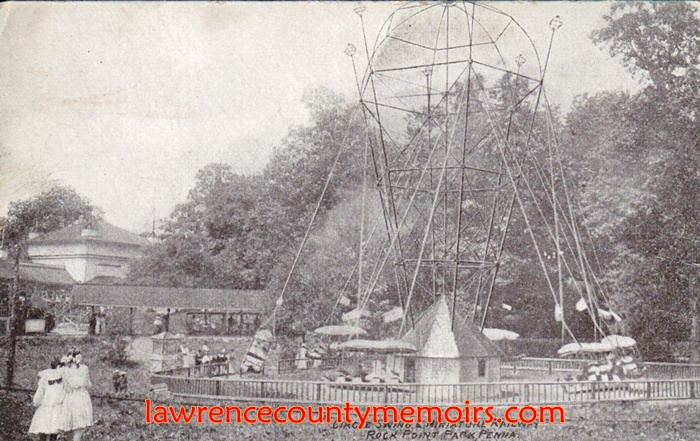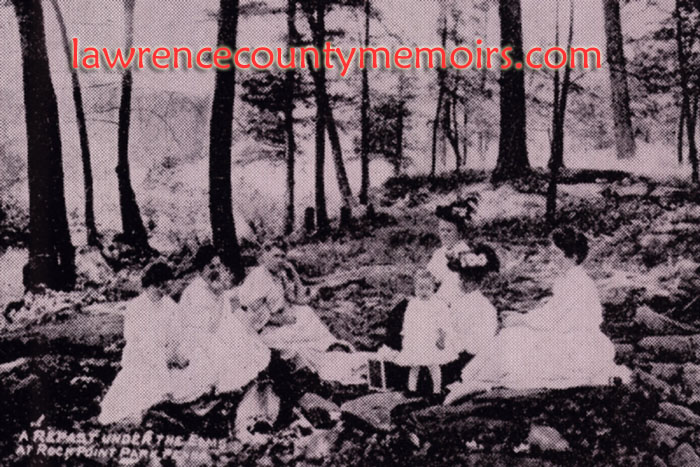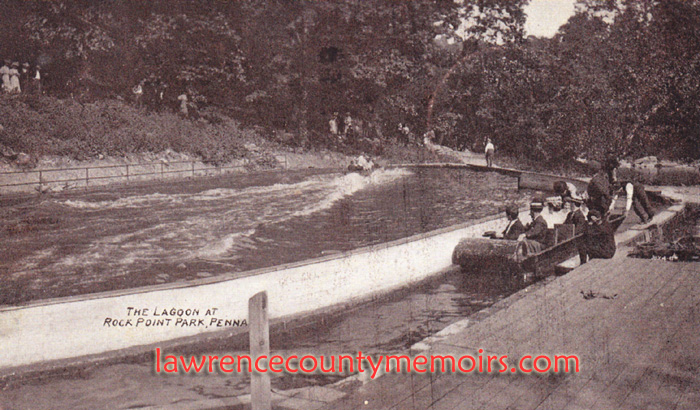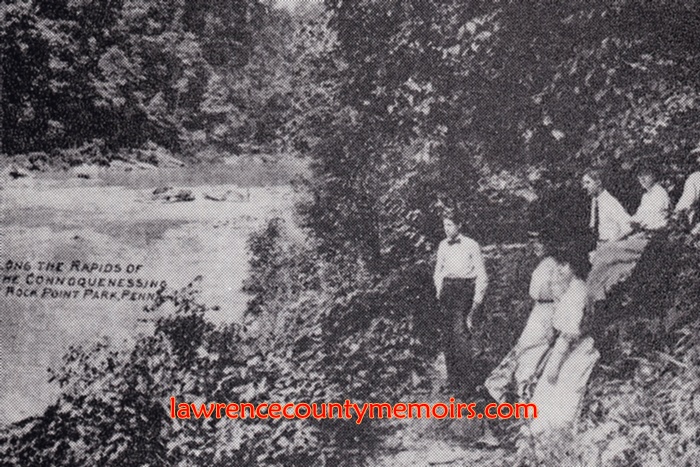In 1831 construction got underway on the sixty-one-mile-long Beaver Division of the Beaver & Erie Canal, the southernmost of the three sections or “divisions” of the canal that basically connected Pittsburgh to Lake Erie in western Pennsylvania. The Beaver Division’s southern terminus started at the Ohio River at Rochester, traveled north along the east bank of the Beaver River, crossed over the mouth of the Connoquenessing Creek at Rock Point, and then continued northward up to New Castle and onto Pulaski. Hundreds of wooden shallow-draft “packet boats” and “line boats” plied the canal day and night carrying their lucrative freight and passengers.
All along the route small settlements known as “canal towns,” some already existing and others just springing to life, flourished due to the trade and visitors the waterway brought. Among the towns or areas that benefited were New Brighton, Rock Point, Chewton, Staylesville (or Hardscrabble), Old Moravia, Mahoningtown, New Castle, Harbor Bridge, Pulaski, and West Middlesex.
In particular the area of Rock Point in Wayne Township, at the confluence of the Connoquenessing Creek and Beaver River, was steeped in the romantic history of the “old ditch.” It was here in 1836 that Moses Matheny started building a stone inn and tavern that was completed by his son Aaron Matheny the following year. Many people stopped there for the night and among the famous people known to have passed through on canal boats include iconic English writer Charles Dickens (1812-1870), American adventurist and author James Fenimore Cooper (1789-1851), and U.S. Presidents Zachary Taylor (1784-1850) and James A. Garfield (1831-1881).
The canal – and the Matheny Inn – flourished for several decades but the coming of the railroads helped hasten its demise. Beginning in 1852 the Ohio & Pennsylvania Railroad (O&P) was the first railroad to begin operating through Lawrence County. Others followed in the coming years and a sharp decline in freight business signaled the demise of the canal. The Erie & Pittsburgh Railroad (E&P), under lease by the powerful Pennsylvania Railroad (PRR), purchased the canal in 1870 and continued to operate for about a year. Afterwards, only the lower portion of the canal (below New Castle) remained in use for a few years. The locks, tollhouses, and equipment were sold off or put to use by the railroad.
The level towpaths and filled-in canal beds would offer a natural right-a-way for railroad tracks and this made any existing canals desirable for takeover by the railroad companies. Before too long the a narrow-gauge railroad track was laid along the lower stretches of the former canal for the New Brighton & New Castle Railroad (NB&NC), which ran from New Brighton (Kenwood) through the Rock Point area and northward to Chewton/Wampum. The stone used to construct the piers for the railroad bridge at Rock Point, which opened in 1874, were taken from the nearby canal lock.
The closing of the canal also brought about demise of various businesses such as the historic Matheny Inn at Rock Point, which closed due to a lack of patronage in 1872. In 1881 local man Thomas Warnock purchased Matheny Inn and surrounding area with plans to operate it as a hotel, but he sold it a year later. The new owner was Ferdinand Venn, a doctor from Pittsburgh, who operated the inn as a hotel and a sort of health resort.
In 1886 the New Brighton & New Castle Railroad (NB&NC), under control of the PRR, acquired the property and began making various improvements. The old Matheny Inn was converted into a train depot, various small amusement rides and concession stands were added, nature trails and picnic areas were developed, and the property was dubbed Felician Park. Additional property was acquired in the next few years and the park was expanded to 145 acres. Within a few years – and no later than 1889 – the locals began referring to the property as Rock Point Park.
In 1889 an iron footbridge was constructed to allow pedestrian access from the nearby community of Park Gate, on the south side of the Connoquenessing Creek. The following year the Pittsburgh & Lake Erie Railroad (P&LE) began their shortline service into Ellwood City and opened a passenger station at Park Gate. The park soon became a popular summertime destination, as daily trains brought folks from distant locales such as Pittsburgh and Youngstown.
The early 1890’s were the heyday of Rock Point Park and just over 82,000 people reportedly visited the park during the summer of 1890. Improvements continued as a large roller coaster and a merry-go-round, a small hotel and comfort stations, a bowling alley and a baseball field, and several dance and dining halls were erected in the coming years. As suddenly as the amusement park shot to prominence it seemed to fade back into semi-obscurity. By the end of the century, with the opening of rival “trolley parks” such as Cascade Park in New Castle (opened 1897), Kennywood Park in West Mifflin (1898), and Terminal/Idora Park in Youngstown (1899), the attendance at Rock Point Park began to decline significantly.
The park was closed in 1903 and 1904 as the railroad bridge across the Connoquenessing was replaced with a newer double-track structure. I believe in 1905 a group known as the Rock Point Amusement Company took over management of the park and attempted to revive it. The classical Peristyle building, the Shoot-the-Chutes water ride, and a miniature train were all added at this time. The park, though suffering from declining attendance, experienced a bit of a revival and a article in the New Castle News of June 16, 1911, reads, “The list of bookings for Rock Point park this summer was issued today by Manager Eicholtz. The list includes some very large outings and the indications are that the park will have a very successful season.”
When the railroads ended their unprofitable passenger service to Rock Point by the end of 1911 the death knell was sounded. Their was serious talk of a new streetcar line to serve Rock Point, but it was not until early 1915 that the Harmony Streetcar Line was extended through the area and on to Beaver Falls. In late June 1912, as the park would normally be opened for the season, it was announced the park was being closed indefinitely. A few of the structures were dismantled and sold off for lumber, although I believe the owners held out hope that the park could be reopened at a later time.
Any dreams of reopening the park were dashed by a disastrous fire that occurred on the late afternoon of Thursday, April 15, 1915. The park had suffered several small fires in recent years, but this one dashed any hope of reopening the park. The fire started about 4:00pm in the dancing pavilion and investigators theorized it was started by sparks thrown from a passing locomotive. An article in the New Castle News of April 16, 1915, read in part, “The total loss is estimated at $35,000 and the buildings burned included the dancing pavilion, a hotel, merry-go-round, roller coaster and a large water tank. Many of the trees of the park were also destroyed by the flames. Owing to the intense heat it was impossible for the volunteer fire fighters to approach the blaze. At times the flames rose hundreds of feet in the air. Dead limbs of trees high in the air were ignited by the flames and the fire burned rapidly through these limbs to the trunk of the trees until the whole tree had been destroyed. Many of the trees were chopped down by the fire fighters in an effort to prevent the spread of the blaze.”
The park was sold to a private owner in 1916 and in the early 1920’s the property was leased to a company to conduct limestone mining operations. Most of the abandoned structures were torn down at this time and the old Matheny Inn finally collapsed in 1936. In about 1940 the Nastas family of Park Gate purchased the property. It appears there was talk of redevelopment as the February 5, 1942, edition of the New Castle News has an classified advertisement that reads, “NOTICE: Re-opening Old Rock Point Park. Have opening for roller skating rink, dancing hall, horse racing and pony tracks. Nancy Nastas, Park Gate. Ellwood City, PA.” Despite whatever efforts were undertaken the property remained closed to the general public for much of the next six decades. In the summer of 1960 three local men officially established the Rock Point Boat Club, and were allowed to utilized the property to build a clubhouse and boat launches.
In 2007 the Pennsylvania Wild Waterways Conservatory (WWC) of Zelienople spent $455,000 to acquire 100 acres of property at Rock Point, which included the grounds of the old Rock Point Park. The WWC received a large state grant and the purpose of the nonprofit group is publicly listed as “…to protect and enhance the natural resources of the Connoquenessing and Slippery Rock Watersheds.” The property was transformed into a nature park and reopened to the public in 2008 as the Rock Point Nature Area. The Rock Point Boat Club was allowed to continue its operations at the site as well.
The park is open to the public and with a little investigation one can find a few remnants, mostly concrete foundations as well the old PRR railroad bridge, that once supported the short-lived glory days of Rock Point Park. To learn more about Rock Point Park visit the great website created by Bruce Draganjac called www.rockpointpark.com.
 In 1889 this iron footbridge across the Connoquenessing Creek was built to provide pedestrian access to the park from the Park Gate area. (c1905) |
 Rock Point Park was a Victorian-sytle amusement park that was in operation from 1886 until in closed for good after the 1911 season. The back of this postcard has a printed advertisement that reads, “Rock Point Park, Pa. The residents of the “Pittsburg District,” West Virginia and Eastern Ohio, find here the “Happy Hunting Ground” where fun, pleasure and satisfaction awaits them. Once a visitor always a friend.” (c1900) Full Size |
 Attendance peaked in 1890 and the facility, facing competition from similar parks, went into a slow decline. (c1905) |  Patrons enjoying a leasurely afternoon at the park. (c1905) |
 (1911) |
 Postcard dated on back as October 21, 1908, showing folks enjoying the amusement area of Rock Point Park near the confluence of the Beaver River and Connoquenessing Creek. |
 In the lagoon at the bottom of the Shoot the Chutes ride at the park. This postcard is postmarked Aug 5, 1908. |
 A postcard showing the Shoot the Chutes ride, just as a toboggan hits the lagoon. (1907) |  Another postcard of the popular Shoot the Chutes ride. (1907) |
 A postcard postmarked Aug 3, 1906, showing the boat landing area along the Connoquenessing Creek. |
 This postcard provides a view of the ballfield at Rock Point Park, which had a large grandstand seating area behind home plate. (c1909) Full Size |
 A PRR train drops folks off for an afternoon at Rock Point Park. (c1909) |  Some of the “rocks” that inspire the name Rock Point. (c1908) |
 The wooden roller coaster was opened in c1890. It was lost to the devastating fire that burned down much of the amusement park on April 15, 1915. Despite the folks having fun on the front of this card the back reveals some terrible news. This postcard was sent to Mr. James Bennett in Grove City on March 23, 1911. It sadly reads, “Dear Brother, am sorry to write to tell you that Little Hilda Noble died this evening from dyptheria and Mrs. has it now. They are getting Jessica Montgomery this evening. They are going to bury at Grove tomorrow but no one can go and do a thing… Write back soon, Mary.” Full Size |
 The main park grounds sit empty. (c1910) Full Size |
 A view of the boat house and boating area of the park. (c1908) |  Boaters enjoy a day on the Connie Creek. (c1907) |
 The Connoquenessing Creek near Rock Point. (c1903) Full Size |
 The footbridge across the Connie Creek. (c1911) |  Another view of the footbridge that connected the park with nearby Park Gate. (c1910) |
 The Women’s Cottage, a comfort station and restroom for the ladies, at the park. This building was later relocated to Ellwood City and remodeled into a home on College Street near the North Side School. (c1907) Full Size |
 Park patrons relax along the banks of the Connoquenessing Creek. (c1905) |  The “rocks” of Rock Point. (c1906) |
 The Shoot the Chutes water ride at the park. (c1906) Full Size |
 The remnants of the old Matheny Tavern long after it was closed. This and most of the other abandoned structures at the former park were eventually cleared away. (c1935) |











Comments
Chris Pavkovich #
Saddens me to think this was lost. Part of me wishes it could be restored.
Glenn Pierce #
who owns rock point area now, would like to walk around and maybe netal detect around the area
Comment